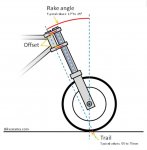Claviger
Aspiring Student
- Joined
- Jul 25, 2014
- Messages
- 6,934
- Location
- Olympia Washington
- Ride
- '21 Z H2, '14 R3R, '02 Daytona 955i
I wonder what handling characteristic this delivers? There is a reason for it but I don’t understand bike geometry enough to know why they do this. Hope someone here can explain it to me.
I'll take a stand at it, but there are others on the board who know far more about this than I do.
I assume you're talking about the centerline of the axle being offset from the centerline of the fork tubes, more rearward for the axle.
It'll change the trail measurments for a given rake angle either increasing or decreasing it depending on which direction you move the axle.
In this case the direction they moved it creates extra trail, likely in an attempt to stabilize the front end and account for the 4 (I think) degree sharper rake angle compared to the older Rocket.
It provides the effect of creating a more agile bike due to rake angle, yet should maintain the self centering effect the large trail on the current rocket has, making it stable at speed and mid-corner.
Turn initiation should be light, with no apparent trade off in stability vs the Rocket 3 Roadster.
The 140/75R17 (or 150/70R17) // 240/55R16 combo so many of us love may be unsuited to the new bike because of the change, the effect of the diameter change might be magnified by the two good bit to geometry; increasing rear and lowering front which effectively sharpens take angle and shortens trail.
For comparison I found my geometry measurments I took painstakingly last year. So compare those with the new published numbers and you'll see Triumph was after the agility of 28 degrees with the stability of 5.3" of trail. This means Mufasa is inherently less stable and more agile than the new bike is, take that triumph.
Mufasa
Wheelbase 65"
Trail 4.5"
Rake Angle - 28.3 degrees
New R3GT/R
Wheelbase 66"
Rake 27.9 degrees
Trail 5.3"
Last edited:


